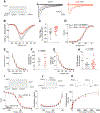A modulator of the low-voltage-activated T-type calcium channel that reverses HIV glycoprotein 120-, paclitaxel-, and spinal nerve ligation-induced peripheral neuropathies
- PMID: 32541387
- PMCID: PMC7572723
- DOI: 10.1097/j.pain.0000000000001955
A modulator of the low-voltage-activated T-type calcium channel that reverses HIV glycoprotein 120-, paclitaxel-, and spinal nerve ligation-induced peripheral neuropathies
Abstract
The voltage-gated calcium channels CaV3.1-3.3 constitute the T-type subfamily, whose dysfunctions are associated with epilepsy, psychiatric disorders, and chronic pain. The unique properties of low-voltage-activation, faster inactivation, and slower deactivation of these channels support their role in modulation of cellular excitability and low-threshold firing. Thus, selective T-type calcium channel antagonists are highly sought after. Here, we explored Ugi-azide multicomponent reaction products to identify compounds targeting T-type calcium channel. Of the 46 compounds tested, an analog of benzimidazolonepiperidine-5bk (1-{1-[(R)-{1-[(1S)-1-phenylethyl]-1H-1,2,3,4-tetrazol-5-yl}(thiophen-3-yl)methyl]piperidin-4-yl}-2,3-dihydro-1H-1,3-benzodiazol-2-one) modulated depolarization-induced calcium influx in rat sensory neurons. Modulation of T-type calcium channels by 5bk was further confirmed in whole-cell patch clamp assays in dorsal root ganglion (DRG) neurons, where pharmacological isolation of T-type currents led to a time- and concentration-dependent regulation with a low micromolar IC50. Lack of an acute effect of 5bk argues against a direct action on T-type channels. Genetic knockdown revealed CaV3.2 to be the isoform preferentially modulated by 5bk. High voltage-gated calcium, as well as tetrodotoxin-sensitive and -resistant sodium, channels were unaffected by 5bk. 5bk inhibited spontaneous excitatory postsynaptic currents and depolarization-evoked release of calcitonin gene-related peptide from lumbar spinal cord slices. Notably, 5bk did not bind human mu, delta, or kappa opioid receptors. 5bk reversed mechanical allodynia in rat models of HIV-associated neuropathy, chemotherapy-induced peripheral neuropathy, and spinal nerve ligation-induced neuropathy, without effects on locomotion or anxiety. Thus, 5bk represents a novel T-type modulator that could be used to develop nonaddictive pain therapeutics.
Conflict of interest statement
CONFLICT OF INTERESTS STATEMENT
R. Khanna is the co-founder of Regulonix LLC, a company developing non-opioids drugs for chronic pain. In addition, R. Khanna has patents US10287334 and US10441586 issued to Regulonix LLC. R. Khanna and Jun Wang have filed disclosures on the composition of matter and use of
Figures










References
-
- Aziz-Donnelly A, Harrison TB. Update of HIV-Associated Sensory Neuropathies. Curr Treat Options Neurol 2017;19(10):36. - PubMed
-
- Bauer CS, Rahman W, Tran-van-Minh A, Lujan R, Dickenson AH, Dolphin AC. The anti-allodynic alpha(2)delta ligand pregabalin inhibits the trafficking of the calcium channel alpha(2)delta-1 subunit to presynaptic terminals in vivo. Biochemical Society transactions 2010;38(2):525–528. - PubMed
-
- Bellampalli SS, Ji Y, Moutal A, Cai S, Wijeratne EMK, Gandini MA, Yu J, Chefdeville A, Dorame A, Chew LA, Madura CL, Luo S, Molnar G, Khanna M, Streicher JM, Zamponi GW, Gunatilaka AAL, Khanna R. Betulinic acid, derived from the desert lavender Hyptis emoryi, attenuates paclitaxel-, HIV-, and nerve injury-associated peripheral sensory neuropathy via block of N- and T-type calcium channels. Pain 2019;160(1):117–135. - PMC - PubMed
Publication types
MeSH terms
Substances
Grants and funding
LinkOut - more resources
Full Text Sources
Research Materials

